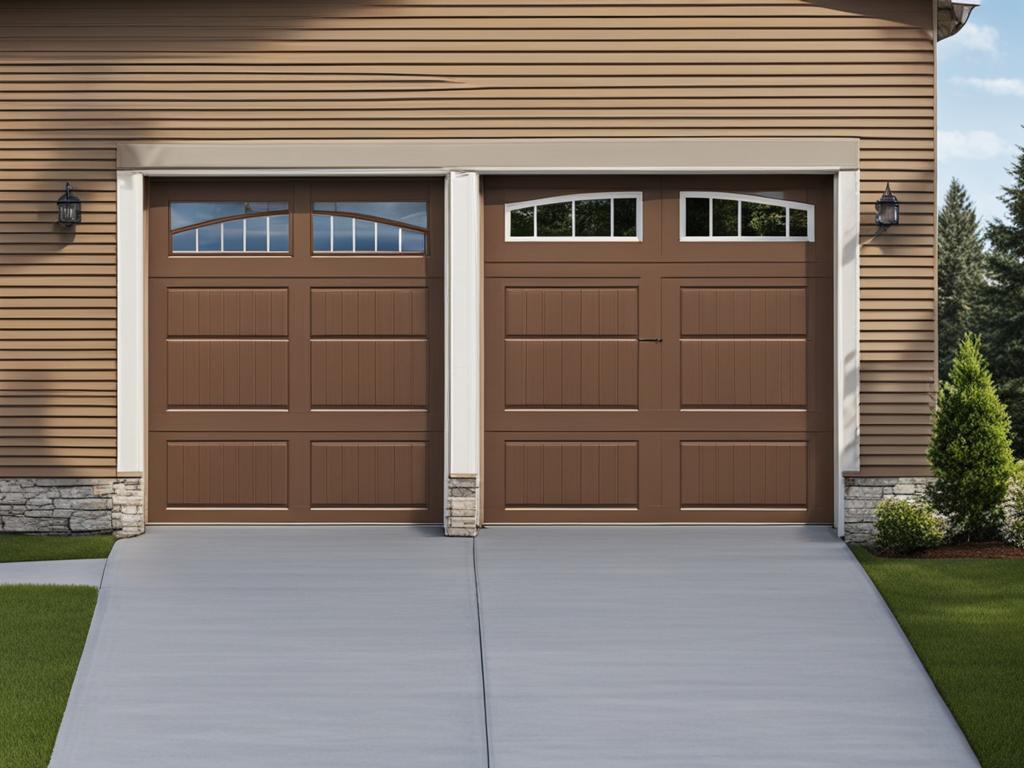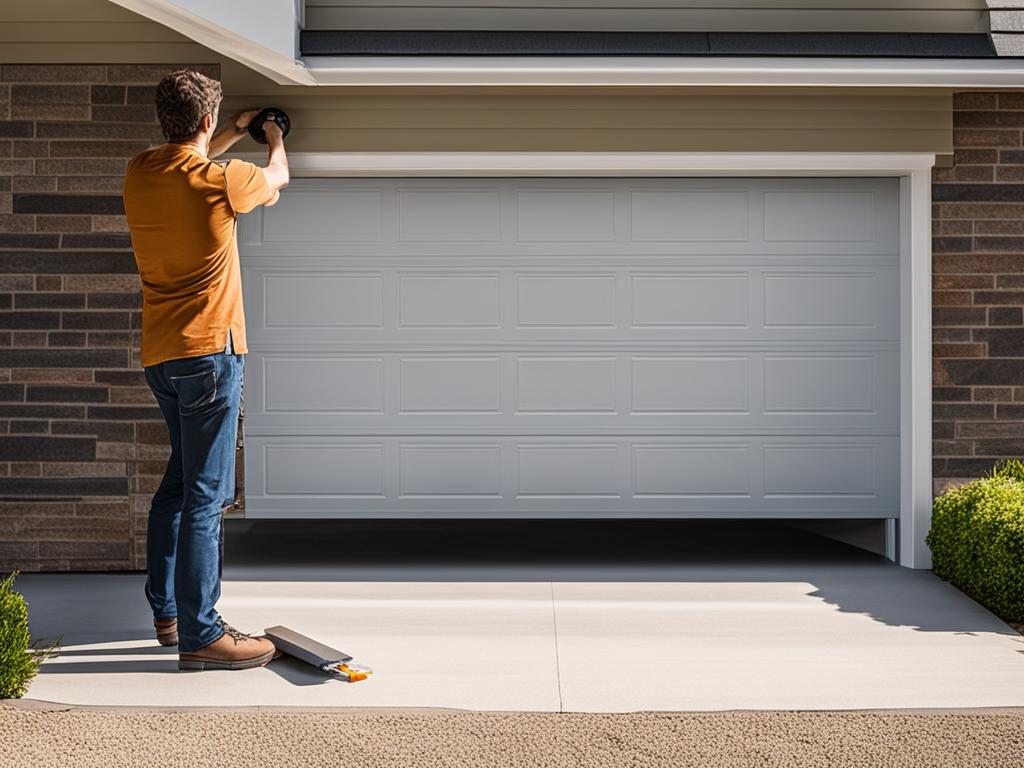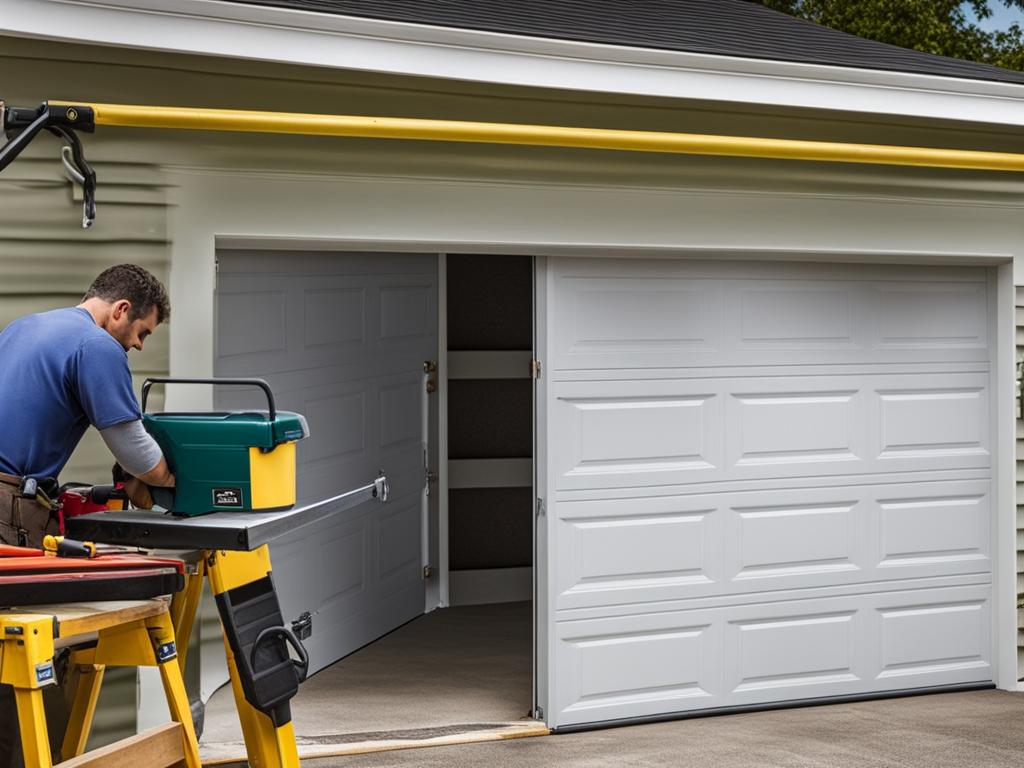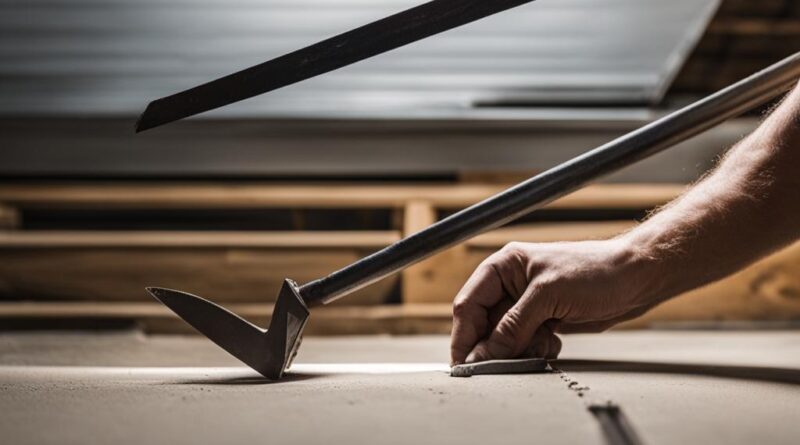Master the Basics: How to Level a Garage Door Effortlessly
Leaving your garage door uneven can pose safety hazards and lead to costly repairs or replacement. Learning how to level a garage door is essential for maintaining its functionality and safety. Fortunately, leveling a garage door can be done easily with some basic guidelines and tools.
Key Takeaways
- Leveling a garage door is important for safety and preventing costly repairs.
- An uneven garage door can pose risks and is more prone to damage.
- Safety precautions should be taken before starting the leveling process.
- Signs of an uneven garage door include changes in movement and visible misalignment.
- There are multiple solutions for leveling a garage door, including adjusting both sides, garage door spring tension, and lift cable adjustment.
The Importance of Leveling a Garage Door
An uneven garage door not only looks unsightly but also poses safety risks. When a garage door is out of balance, it can close or open unexpectedly and at a faster rate, which can be dangerous for anyone nearby. Additionally, an uneven garage door is more prone to damage, leading to costly repairs or the need for a new door. Properly leveling a garage door is crucial for its smooth operation and safety.
By maintaining a level garage door, you ensure that it opens and closes smoothly, reducing the risk of accidents or injuries. A balanced garage door also helps to prevent strain on the motor and other components, prolonging their lifespan and minimizing the need for repairs. Moreover, a level garage door improves the overall curb appeal of your home, enhancing its aesthetic value.
Regularly checking and leveling your garage door can prevent further damage and save you money in the long run. It is recommended to include garage door leveling as part of your routine maintenance tasks to ensure the optimal functionality and safety of your garage door.
Table 2: Benefits of Leveling a Garage Door
| Benefits | Description |
|---|---|
| Enhanced Safety | Prevents unexpected movements and reduces the risk of accidents or injuries. |
| Reduced Repair Costs | Minimizes the likelihood of damage and the need for costly repairs or replacement. |
| Extended Lifespan | Reduces strain on the motor and components, prolonging their durability. |
| Improved Curb Appeal | Enhances the overall appearance of your home, increasing its aesthetic value. |
Properly leveling your garage door is not only essential for functionality and safety but also for the overall investment in your home. By addressing any unevenness and maintaining the balance of your garage door, you can enjoy the benefits of a smooth-operating and visually appealing entrance to your garage.
Safety Precautions before Leveling a Garage Door
Before you begin leveling your garage door, it’s important to prioritize safety by taking the necessary precautions. By following these guidelines, you can ensure a safe working environment and minimize the risk of accidents or injuries.
Safety Precautions:
- Turn off the power: Before starting any work on your garage door, make sure to turn off the power to avoid electrical accidents. This can be done by disconnecting the garage door opener from the electrical outlet or turning off the circuit breaker.
- Use a stable ladder: When working at heights, always use a stable ladder that is of an appropriate height and in good condition. Ensure that the ladder is placed on a level surface and securely positioned against the wall or garage door frame.
- Wear proper safety gear: Protect yourself by wearing the appropriate safety gear, including safety glasses, gloves, and closed-toe shoes. This will help prevent injuries from falling objects or accidental contact with moving parts.
By following these safety precautions, you can create a safe and secure environment for leveling your garage door. Remember to always prioritize your safety and take the necessary steps to minimize any risks.
| Safety Precautions | Importance |
|---|---|
| Turn off the power | Prevents electrical accidents |
| Use a stable ladder | Ensures stability and balance while working at heights |
| Wear proper safety gear | Protects against potential injuries from falling objects or moving parts |
Always adhere to these safety precautions before and during the process of leveling your garage door. Creating a safe environment is essential for a successful and accident-free repair or adjustment.
Identifying an Uneven Garage Door
Before attempting to level a garage door, it is crucial to first identify if it is uneven. By carefully observing the movement and appearance of the door, you can determine if it needs to be leveled. Here are some signs to look out for:
- Quicker or slower movement in certain areas: Pay attention to any areas where the door may be moving faster or slower than usual. This could indicate an imbalance.
- Noticeable gap underneath the door: If you see a significant gap between the bottom of the door and the ground, it may be a sign of unevenness.
- Visible misalignment when closed: When the door is completely closed, check if it appears crooked or misaligned. This could indicate that it needs to be leveled.
By being aware of these signs, you can determine whether your garage door requires leveling to ensure its proper functionality and safety.
Table: Signs of Garage Door Imbalance
| Signs | Explanation |
|---|---|
| Quicker or slower movement in certain areas | Unevenness in the door’s movement can indicate an imbalance, potentially caused by uneven spring tension or misaligned tracks. |
| Noticeable gap underneath the door | An excessive gap between the door and the ground can suggest that the door is not level and may require adjustment. |
| Visible misalignment when closed | If the garage door appears crooked or misaligned when fully closed, it is a clear sign that it needs to be leveled. |

Always remember to exercise caution when inspecting and working on your garage door. If you are unsure about the level of expertise required or if the issue seems beyond your capabilities, it is always best to seek professional help.
Solution 1 – Adjusting Both Sides of the Garage Door
When it comes to leveling a garage door, one effective solution is to adjust both sides of the door. This method involves measuring the gap underneath the door and the diameter of the shaft and drum to ensure accurate adjustments. By tightening the set screws on the drum on one side, the other side will rise, evening out the door.
To further level the gap side, you can make marks on the cable drum and gradually tighten the set screw until the marks align. It is important to make small adjustments and test the door after each modification to achieve the desired leveling. Repeat the process if necessary until the garage door is properly balanced.
| Steps to Adjust Both Sides of the Garage Door |
|---|
| Tighten the set screws on the drum of one side of the door. |
| Observe the movement of the door and make small adjustments until the door is balanced. |
| Make marks on the cable drum of the gap side and tighten the set screws gradually until the marks align. |
| Test the door after each adjustment to ensure proper leveling. |
| Repeat the process if needed until the garage door is level. |
Adjusting both sides of the garage door is a straightforward method that can help restore balance and ensure smooth operation. However, it is important to approach the process with caution and make gradual adjustments to avoid potential damage or misalignment of the door.
Solution 2 – Adjusting the Garage Door Spring Tension
When it comes to leveling a garage door, adjusting the tension on the garage door springs can be an effective solution. The springs play a crucial role in counterbalancing the weight of the door, ensuring smooth and controlled movement. If the door is uneven, it could indicate issues with the spring tension.
To adjust the garage door spring tension, start by opening the door completely to relieve the tension. This can be done by pulling the emergency release cord and manually lifting the door until it is fully open. Once the tension is released, locate the adjustment collar on the spring shaft. This collar is typically marked with a “+” and “-” sign, indicating the direction to turn for tightening or loosening.
Using a winding bar or an adjustable wrench, carefully turn the adjustment collar in the appropriate direction to achieve the desired tension. It’s important to adjust both springs in the same way to maintain balance. Keep in mind that adjusting the spring tension can be dangerous and should be done with caution. If you’re unsure or uncomfortable working with garage door springs, it’s best to seek professional assistance.
| Pros of Adjusting Garage Door Spring Tension | Cons of Adjusting Garage Door Spring Tension |
|---|---|
| Can help level an uneven garage door | Requires knowledge and experience to adjust properly |
| Cost-effective solution | Can be dangerous if not done correctly |
| May improve overall door performance | May not resolve all leveling issues |
Remember, garage door springs are under high tension and can cause serious injury if mishandled. If you’re not confident in your abilities or lack experience, it’s always best to leave garage door spring adjustment to the professionals. Your safety should be the top priority when working on any garage door repairs or adjustments.
Solution 3 – Adjusting the Lift Cable
Adjusting the lift cable is another method to consider when leveling a garage door. This technique can be particularly useful if the previous adjustments to the sides and springs did not achieve the desired level. By making adjustments to the lift cable, you can further fine-tune the balance of the garage door.
To adjust the lift cable, start by propping open the garage door securely. This will ensure that the door remains in an elevated position while you work on the cable. Next, identify the lift cable and locate the tension adjustment mechanism, which is usually a nut or a similar component.
Using appropriate tools, such as a wrench, tighten or loosen the tension on the lift cable according to the direction needed to level the door. Make small adjustments and then carefully test the door by opening and closing it to check if the leveling has improved. It may take several iterations of adjusting the lift cable to achieve the desired result.
Note: When adjusting the lift cable, always prioritize safety and ensure that the garage door is properly secured to prevent accidents or injuries.
By combining the adjustment methods mentioned in the previous sections, homeowners can effectively level their garage doors and optimize the functionality of the door. However, it is important to note that these methods should be executed carefully and with proper understanding to avoid causing further damage or compromising safety.
Testing the Garage Door Leveling
Once you have made the necessary adjustments to level your garage door, it is important to thoroughly test it to ensure it is properly balanced. This will help ensure its smooth operation and prevent any future issues. Testing the garage door involves opening and closing it multiple times to see if it moves smoothly and evenly.
During the testing process, pay close attention to any signs of imbalance or uneven movement. If the door still shows signs of being out of level, it may be necessary to repeat the adjustment process or further inspect for any underlying issues.
Remember to always prioritize safety when testing the garage door. Ensure that the area is clear of any obstructions, and keep a safe distance while operating the door. If you notice any unusual noises, jerky movements, or other abnormalities, it may indicate a problem that requires further attention.
Regularly testing your garage door’s leveling is an important part of its maintenance routine. By ensuring that it is properly balanced, you can prevent potential safety hazards and costly repairs in the future.
Table: Garage Door Testing Checklist
| Testing Step | Actions |
|---|---|
| Open the door | Slowly open the garage door and observe its movement. |
| Close the door | Close the door and ensure it moves smoothly and evenly. |
| Observe for imbalance | Look out for any signs of imbalance or uneven movement during the testing process. |
| Listen for unusual noises | Pay attention to any unusual noises or jerky movements that may indicate a problem. |
| Repeat the test | If necessary, repeat the testing process to ensure the garage door is properly leveled. |
Troubleshooting Garage Door Leveling
Even after following the initial adjustment steps for leveling a garage door, there may still be lingering issues that require further troubleshooting. Here are some additional tips to help address common leveling problems:
Inspect the Tracks and Hardware
One possible cause of an uneven garage door is damage or obstructions in the tracks. Inspect the tracks for any bends, dents, or debris that may be affecting the door’s movement. Additionally, check the hinges and other hardware for any looseness or damage. Tighten any loose screws or nuts and replace any damaged parts to ensure smooth operation.
Check for Balance and Alignment
If the garage door is still not level, it may be helpful to assess its balance and alignment. Use a level to check if the door is parallel to the ground and adjust the tracks or other components as needed. Also, make sure that all the cables and springs are properly attached and tensioned. Correcting any discrepancies in balance and alignment can contribute to better leveling results.
Keep the Door Clean and Lubricated
Over time, dirt and debris can accumulate on the garage door and its components, affecting its overall performance. Regularly clean the door with mild soap and water, and ensure that the tracks are free from any buildup. Additionally, lubricate all moving parts, such as hinges, rollers, and springs, with a silicone-based garage door lubricant. This will help reduce friction and allow for smoother operation, potentially improving the leveling of the door.
Remember, troubleshooting garage door leveling requires patience and careful observation. If the issues persist or become more complex, it is advisable to seek professional assistance to ensure proper leveling and safe operation of the garage door.

| Troubleshooting Tips: |
|---|
| Inspect the tracks and hardware for any damage or obstructions. |
| Check the balance and alignment of the door. |
| Keep the door and its components clean and lubricated. |
When to Seek Professional Help
While many garage door leveling issues can be resolved with DIY methods, there are instances when it is best to seek professional help. Cases where there is extensive damage, electrical issues, or if the repair requires specialized knowledge and tools should be handled by a trained garage door expert. It is important to assess the complexity of the issue and prioritize safety when deciding whether to hire a professional.
Garage door experts have the experience and expertise to identify and address underlying issues that may not be apparent to the average homeowner. They have the necessary tools and equipment to safely and effectively level a garage door, ensuring optimal functionality and long-term durability. Additionally, hiring a professional can save homeowners time and effort, as they can quickly assess the problem and provide an efficient solution.
Professional help should also be sought when dealing with complex garage door systems, such as those with advanced automation features or custom installations. These systems often require specialized knowledge and training to properly diagnose and repair. Attempting to fix such systems without the appropriate expertise can lead to further damage or even personal injury.
| Signs That You Should Seek Professional Help for Garage Door Leveling: |
|---|
| Extensive damage to the garage door or its components |
| Electrical issues, such as malfunctioning sensors or wiring problems |
| Garage door with advanced automation features |
| Custom or specialized garage door installations |
| Inexperience or lack of confidence in tackling the repair |
Overall, while DIY garage door leveling can be a cost-effective option for simpler issues, seeking professional help ensures the job is done correctly and safely. Consulting with a garage door expert can provide homeowners with peace of mind and guarantee a level garage door that functions smoothly and reliably.
Proper Maintenance for a Level Garage Door
Once you have successfully leveled your garage door, it is important to prioritize regular maintenance to ensure its continued alignment and optimal functionality. By following these maintenance tips, you can prolong the lifespan of your garage door and prevent future issues.
Regular Inspection and Cleaning
Performing regular inspections of your garage door and its components is essential for identifying any signs of wear or damage. Inspect the tracks for debris or obstructions that may affect the smooth operation of the door. Clean the tracks and hardware using a mild detergent and a soft brush to remove any built-up dirt or grime.
Additionally, inspect the hinges and hardware for any looseness or damage. Tighten any loose screws or bolts and replace any worn-out or damaged parts promptly. By addressing these issues early on, you can prevent further damage and ensure that the door remains properly aligned.
Lubrication of Moving Parts
Proper lubrication is crucial for the smooth and quiet operation of your garage door. Regularly lubricate the moving parts such as the hinges, rollers, and springs using a silicone-based lubricant. Avoid using oil-based lubricants as they can attract dirt and debris, causing the door to malfunction.
Apply the lubricant sparingly, focusing on the pivot points and areas where metal components meet. This will help reduce friction and ensure that the door moves smoothly along the tracks. Remember to wipe off any excess lubricant to prevent accumulation.
Addressing Signs of Wear or Damage Promptly
If you notice any signs of wear or damage during your inspections, it is important to address them promptly. Replace any worn-out or damaged parts, such as worn-out weatherstripping or frayed cables, as soon as possible. Ignoring these issues can lead to further damage and affect the alignment and functionality of your garage door.
Regular maintenance and prompt repairs are key to maintaining a level garage door. By following these guidelines and performing routine inspections and cleaning, you can ensure that your garage door remains properly aligned, operates smoothly, and provides optimal functionality and safety for years to come.

Conclusion
Properly leveling a garage door is essential for maintaining its functionality and safety. An uneven garage door can pose safety risks and lead to costly repairs or replacement. By following the guidelines and using the necessary tools, homeowners can easily level their garage doors and ensure smooth operation.
Remember to take necessary safety precautions before starting any garage door repairs or adjustments. Turning off the power to the garage door, using a stable ladder, and wearing proper safety gear are crucial for minimizing risks. Safety should always be a top priority.
In some cases, seeking professional help may be necessary. If the garage door has extensive damage, electrical issues, or requires specialized knowledge and tools, it is best to hire a trained garage door expert. Prioritize safety and assess the complexity of the issue when deciding whether to DIY or seek professional assistance.
Maintaining a level garage door involves regular inspections, cleaning, and lubrication. By addressing any signs of wear or damage promptly and performing consistent maintenance, homeowners can ensure their garage doors remain level and operate smoothly for years to come.
FAQ
What are the signs of an uneven garage door?
Signs of an uneven garage door include a quicker or slower movement in certain areas, a noticeable gap underneath the door, or visible misalignment of the door when closed.
How do I adjust both sides of the garage door to level it?
Measure the gap underneath the door and the diameter of the shaft and drum. Tighten the set screws on the drum on one side to make the other side rise and even out the door. Adjust the gap side by making marks on the cable drum and tightening the set screw until the marks align.
Can adjusting the tension on the garage door springs help level the door?
Yes, adjusting the tension on the garage door springs can help level the door if the imbalance is caused by issues with the springs. Open the door and relieve the tension, then adjust the springs to tighten or loosen the mechanism.
How do I adjust the lift cable to level the garage door?
Prop open the garage door, adjust the cable tension by tightening or loosening it, and then test the door to see if the leveling has improved. Make sure to follow proper safety procedures and ensure the door is properly secured while making these adjustments.
What should I do if the garage door is still not level after adjusting the sides and springs?
If the garage door is still not level after adjusting the sides and springs, you can troubleshoot further by inspecting the tracks for damage or obstructions, checking the hinges and hardware for looseness or damage, and ensuring the door is clean and free from debris.
When should I seek professional help for leveling my garage door?
It is advisable to seek professional help when there is extensive damage, electrical issues, or if the repair requires specialized knowledge and tools. Assess the complexity of the issue and prioritize safety when deciding whether to hire a professional.
How can I maintain a level garage door?
To maintain a level garage door, regularly inspect and clean the tracks and hardware, lubricate moving parts, and address any signs of wear or damage promptly. Consistent maintenance will help ensure the garage door remains level and operates smoothly.

